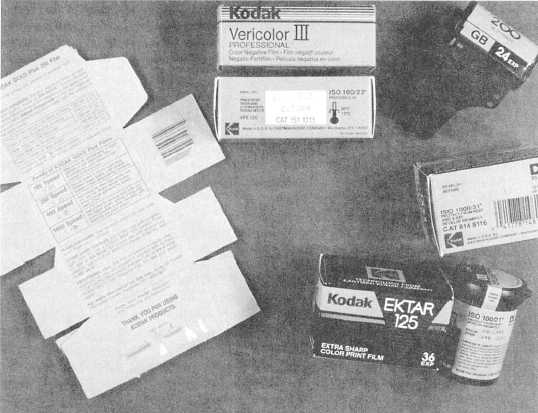302.258
Figure 2-1.–IS0 of film.
The ISO assigned to a film is labeled on the
packaging material and on the film cassette or paper
backing (fig. 2-1). Some types of black-and-white films
are assigned one ISO number; others are assigned two
or more. Whether one or more film speeds are assigned
depends on whether the film responds differently to
different colors or color temperatures of light. Often,
this results in a film having one speed for daylight and
another for tungsten light. The ISO for a particular film
is valid for calculating correct exposure only when that
film is developed as recommended by the manufacturer.
An exposure index is another numerical value
assigned to some films for exposure calculation. The
exposure index is a more accurate method of film speed,
because it is determined by processing a particular film
through the actual process in an imaging facility.
Exposure indexes are generally assigned to films used
for copying or for technical applications.
SPECTRAL SENSITIVITY.–The response of an
emulsion to specific colors of light or radiant energy is
termed coIor or spectral sensitivity. You already know,
from our earlier study of light in chapter 1, that the
visible spectrum is made up of violet, blue, green, and
red light. When speaking of film or emulsion sensitivity,
you are also referring to its sensitivity to ultraviolet and
infrared radiation. Spectral sensitivity of an emulsion
simply means that the emulsion is sensitive to some
energy of the electromagnetic spectrum. Also,
emulsions have color sensitivity, which means they are
sensitive to one or more colors of the visible spectrum.
In this chapter, the terms color sensitivity and color
response are used interchangeably. Color sensitivity or
color response refer to ultraviolet and infrared radiation
as well as visible light.
All silver halides are sensitive to ultraviolet
radiation, violet, and blue light. Color-blind emulsion is
the term given to emulsions sensitive only to these
radiations. The addition of sensitizing dyes to silver
halides can increase the sensitivity of emulsions and
extend their sensitivity to green and red light and
infrared radiation. Increasing the color sensitivity of an
emulsion to other than ultraviolet, violet, and blue is
called dye, color, or optical sensitization.
The color sensitivity of a black-and-white film is an
important characteristic, since it controls the way
colored objects record as tones of gray in the negative
2-2



